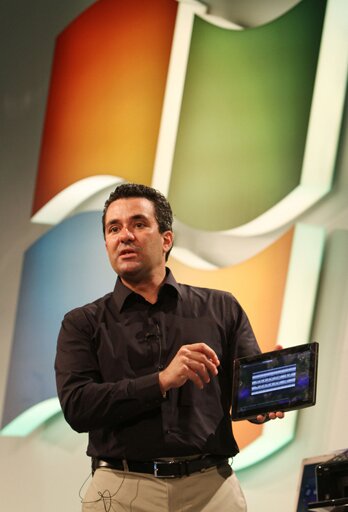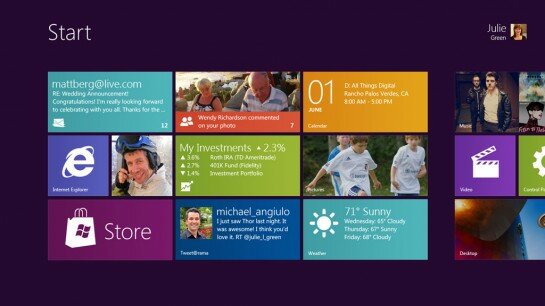 If you’ve seen Microsoft’s latest pictures and videos, you’ll know that Windows 8 looks dramatically different from earlier versions going as far back as Windows 95. In fact, it looks more like the latest Windows Phone 7 smartphone, and that’s not a coincidence. Windows 8 is designed to reach new markets on touch-screen tablets, convertible laptops and all-in-one desktop PCs, but it will still run just as well on traditional laptops and desktop PCs that don’t have touch screens.
If you’ve seen Microsoft’s latest pictures and videos, you’ll know that Windows 8 looks dramatically different from earlier versions going as far back as Windows 95. In fact, it looks more like the latest Windows Phone 7 smartphone, and that’s not a coincidence. Windows 8 is designed to reach new markets on touch-screen tablets, convertible laptops and all-in-one desktop PCs, but it will still run just as well on traditional laptops and desktop PCs that don’t have touch screens.
The familiar Windows desktop is still there if you want it – and if you want to run existing software such as Microsoft Office and Adobe Photoshop, you certainly can do.
When you’re running existing programs, Windows 8 works just like Windows 7, and it will run on the same hardware. In fact, Microsoft is working hard to make Windows more efficient, so if you already have – or plan to buy – a PC that runs Windows 7 or Vista, then Windows 8 should feel slightly better. It’s just that your PC will be able to run two types of applications — desktop and immersive — instead of just one.
Microsoft is bringing “live tiles” to Windows because they are more useful than the dumb icons we’ve had since the 1980s. For example, the live tile for an email application can always show how many new emails you have, just as a clock tile can always show the time. Live tiles make your screen “glanceable”, so you get more up-to-date information and it takes less effort to find it. (There’s a lot of computer science research behind this stuff.)
Windows 8 also brings another dramatic change: it will run on ARM processors such as the Qualicomm Snapdragon and Nvidia Tegra range, not just on Intel or AMD processors. ARM chips are more commonly used in smart phones and tablets.
They are much less powerful than Intel Core processors – which is why Microsoft needs to make Windows 8 more efficient – but they also use less power and generate less heat. ARM chips will enable PC manufacturers such as Asus to make thin and light tablets and laptops with a long battery life that run a full version of Windows, rather than a blown-up smartphone operating system.
Microsoft’s Steven Sinofsky, who is in charge of Windows, pointed out recently that the resources needed by smartphone operating systems are doubling every nine months or so, while Windows’ requirements are shrinking. The two are converging rapidly to the point where it will be possible to run full-blown Windows on a phone.
The main drawback with PCs based on ARM chips is that they can’t run the tens of millions of applications and games created to run on Intel and AMD x86 chips, unless these are specially converted. Microsoft is already converting Microsoft Office, but most Windows applications will remain x86-only for years. ARM-based PCs will therefore appeal mostly to people who do everything on the web using applications such as Hotmail and new Office 365, Gmail and Google Docs. However, they will also be able to download apps from a new app store Microsoft will also launch.
These new “immersive” apps will run on both the ARM- and Intel-based versions of Windows 8. Don’t be surprised if versions also turn up for Windows Phones and the Xbox 360 in some form as well.
Windows’ great strength is that people have been able to run the same applications and use the same skills across a wide range of hardware from portables through desktops and servers right up to supercomputers. With Windows 8, Microsoft is simply extending it to run well on touch-screen devices.
Windows 8 is still a long way from its target release date towards the end of next year, so why has Microsoft started showing it now? Well, it needs thousands of PC manufacturers and hundreds of thousands of software developers to start getting their products ready for the official launch. It would be impossible to run such a large global effort in secret.
Also, most businesses are now committed to installing Windows 7, which is the fastest-selling Windows ever, and they’ll continue to do that even after Windows 8 appears. About 1.4 billion people use Windows PCs, and they’re not all going to upgrade overnight, so if you buy a Windows 7 machine now, it’s not suddenly going to go out of date overnight.
Building “Windows 8″ – Video #1:
If you have any comments on the upcoming Windows 8 OS, please drop us your thoughts below or on our Facebook page.
Related Articles
-
http://www.facebook.com/profile.php?id=617079049 Michael Chaney
-
http://www.facebook.com/jan.kritzinger Jan Kritzinger
-
Imani Franklin
-
http://twitter.com/cloudsmesh Vishal
-
http://www.facebook.com/profile.php?id=1032520703 Michael Oliver
-
http://twitter.com/jackschofield Jack Schofield

